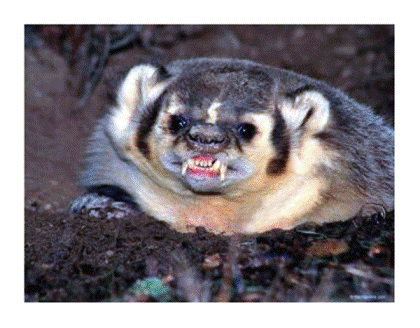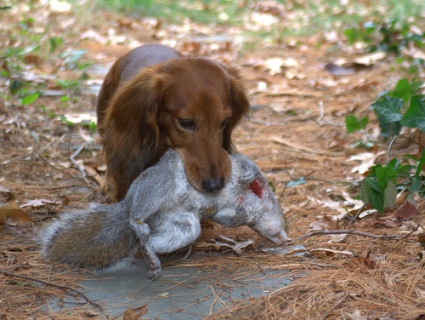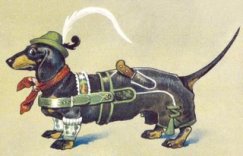
Not human bean, more than a human been!
 Hunting
Hunting
Dachshunds were bred as hunting dogs. They would go into the dens of a badger or fox and chase it out. This required some iron determination to prevail. In fact, the name dachshund means "badger dog." The dachshund has a deep chest to allow enough lung capacity to keep going when hunting. Their noses are long to increase the area that absorbs odors. And the dachshund bark - which, in the standard dachshund, is relatively deep for such a small dog - lets the human locate the dachshund that has gone down a hole after prey. As anyone who has ever owned a dachshund and walked it on a leash can attest, the dachshund is extremely strong in both bone and muscle and it can achieve speeds you would not imagine in a dog with such short legs.
Many people in North America do not realize that the dachshund is the consummate small hunting dog of Europe. The breeding and training of dachshunds that are recognized, respected and used for their specific hunting capabilities in North America. In certain hunting situations, particularly blood tracking and hawking, a good hunting dachshund is more useful than any other breed.
In many European countries a hunter is required by law to use a tracking dog, which helps him find wounded big game. In much of the United States blood tracking with a dog, even on a leash, has been a prohibited activity, outlawed at the time of the general abolition of the use of dogs in deer hunting. However, in the last twenty years quite a few states have passed legislation allowing big game hunting with leashed dogs. For many hunters the dachshund has become the breed of choice.
A shape which is ideal for hunting and earthwork:
- The long strong neck and powerful jaws provide a formidable weapon in confined spaces.
- Those short powerful legs and large feet are ideal for tunnelling.
- The powerful front end with its enlarged muscle anchor ridges (pro-sternum) provides enormous power to the neck, head, and front legs
- Strong hindquarters - to help with excavation of a tunnel, and more importantly, balance and strength when engaging a quarry.
- A very low centre of gravity - this also helps with balance when "doing battle" on a steep hillside or on rough ground.
- Those eyes and ears are so shaped to prevent damage from underground work (not doing unlawful things in the local mall, but doing honest toil under some hillside), or in conflict.
- That lovely loose skin - wonderful to pat, but more importantly, essential for survival in a close tunnel. If a dog gets stuck, it can literally turn inside its suit and get an alternative purchase on the walls.
- Digging is darned hard work, and the dachshund has to have the strength and stamina to both enlarge the tunnel and engage the quarry which has probably been polishing it's own claws and teeth while patiently waiting.
 "Dachshunds are the smallest breed of dog used for hunting."
"Dachshunds are the smallest breed of dog used for hunting."

Firstly, you need to decide what you want to do with your dog. If you decide you want to train your dog to find, flush and retrieve game birds, he will need to have a soft mouth and it is not advisable to also train him to find and dispatch vermin. Similarly, if you want your dog to track wounded game, he must not be introduced to vermin, because for game tracking he needs to be quiet. Vermin hunters give tongue when they are on the scent of vermin and are not useful for tracking when firstly trained for vermin hunting.

Every aspect of what some people think is a funny-looking body has been designed to help the dog achieve its original purpose. The short legs allow the dachshund to burrow deep into the earth after those badgers (or any other earth-dwelling mammals) in their dens. The tail is long and sturdy and extends straight out from the spine, providing a “handle” with which the hunter can retrieve the burrowing dog.
They use their intelligence and speed to often outwit their prey – they do not look for a fight but they will stand their ground against the opposition if they have to. Dachshunds, no matter how well trained, are stubborn and, if you do not catch them with the whistle quickly enough when they put up a hare, you can often be left waiting for a good 20 minutes until they give up the chase and return with their tongues hanging out!
Imagine facing a badger underground, face-to-face where there's no room to turn around. That's what a dachshund was capable of doing successfully, time and again. A badger is one of the fiercest animals in the world.
Dachshunds are selected for nose and for a desire to blood track. If
the desire is not there, nothing will keep a dog working on a
24-hour-old, cold line of a wounded deer. Dachshunds sense of smell is
by far their best sensory organ. These dogs can track a scent that is
weeks old. Be aware that they will often follow a scent and stay from
home if left out. The effective tracking dog must also show intelligence
and an aptitude to discriminate and to pick out and follow the
particular wounded deer's scent line. This line is likely to be overlain
with much fresher scents of healthy deer.
In Europe the hunting dachshund is a dual-purpose dog that hunts and
tracks above ground and bays foxes under ground. Because American foxes
are usually smaller than European foxes, it is not practical in the
United States to breed a dog that is small enough to work our fox dens
and which also has the body mass and strength to go long miles in cold
swamps and heavy cover on the line of a wounded whitetail.

Dangers To Be Aware Of:
- Only ever enter one dog to a hole as there is a strong likelihood that, if a fox is present, the dogs will fight over possession.
- Ensure that the dogs do not enter badger sets. Apart from the legal aspect, dachshunds can suffer severe injuries, and possibly death, as a result of confrontation with a badger.
- Don’t let anyone else take a dog near the hole as, if the fox bolts, there is a danger that the other dog will also chase it and the gunman may lose concentration and shoot a dog instead of the fox.
- Trust your dog—if he thinks there is something in the hole, there probably is; if he is disinterested there is probably nothing there.
- Do not encourage your dog to be reckless; it is far better to avoid injury to your dog and hunt safely. There is no place in the hunting field for macho behaviour.
- Ensure any bites or cuts are thoroughly cleaned and antibiotics administered.
- After any contact with fox or other vermin, check your dog for fleas and ticks.
Dachshunds were bred to hunt, to track scents, and to follow their quarry — with unwavering persistence and courage beyond their size until the prize is won.
An edge on the competition: You can use your Dachshund’s tracking ability for advanced training in competitive tracking, field trials, and earth dog or den trials. These organized sports really take advantage of the Dachshund’s natural abilities, and Dachshunds love to have challenging work to do. Seeing a Dachshund in action, using his natural instincts, is truly inspiring.
Training challenge: If your Dachshund detects a scent while you’re working, training, playing, or walking together, it will take every ounce of doggie willpower for him not to dash off after it. Most of the time, he won’t be able to resist. Your Dachshund is very likely to run away from you if you don’t keep him on his leash in an open area. It isn’t that he doesn’t like you. He’s just a hunter and tracker by nature, and you can’t easily train out instinct.
An edge on the competition: You can use your Dachshund’s tracking
ability for advanced training in competitive tracking, field trials, and
earth dog or den trials. These organized sports really take advantage of
the Dachshund’s natural abilities, and Dachshunds love to have
challenging work to do. Seeing
a Dachshund in action, using his natural instincts, is truly inspiring.
